powered by
FreeFind
Hampshire
Piers
All
images link to larger copies
Hayling Isle Ferry Pontoon
The Hayling
ferry runs from Ferry Point near the Ferry Boat Inn on Hayling
Island to Eastney Beach, Portsmouth, across the mouth of Langstone
Harbour.
The rights to
run a ferry belonged to the Lord of the Manor of Hayling Island,
the Dukes of Norfolk, to whom the land had passed on the dissolution
of the monasteries. Rowing boats were used until 1901 when the
the ferry rights were bought by the Hayling Island Steam Ferry
Company, who constructed pontoons, made up the road on the Hayling
side, and acquired a small steamer. The service was soon abandoned
due to the unsuitability of the steamer. The pontoons survived,
and eventually a motor boat service was operated by G.O.Spraggs
and his sons Cecil, George and Jack. Post-war boats were the
Sinah,
Folkestone
Belle
and
Tarpon.
In 1961 Portsmouth
City Council took the ferry over. I am not sure what boat they
used initially, but by the late 1970s they ran the
Iris of 1968, which carried
55 passengers. She was joined by the Irene of 1976. Portsmouth
City Council operated the ferry until April 1981, when it closed,
no other operator having been found. The pontoons were in poor
condition by this time, and the Eastney pontoon was demolished.
However Hampshire County Council soon found a company who would
take over the service, with subsidy for unprofitable periods.
Dutfield and Edwards started the new service, initially used
the
Hayling
Enterprise
and running onto the beach at Portsmouth until a new pontoon
was built (the Hayling pontoon has also been replaced). The current
boat is the
Pride
of Hayling.
The service runs 360 days a year, with a break over Christmas/New
Year, and carries large numbers of commuters and school children,
plus tourists in summer. Edwards & Co continue to operate
the ferry in 2006. Their contact number is:- 023 924 82868
Unidentified
Hayling ferry at the Hayling pontoon
Scan:
Bill Seager
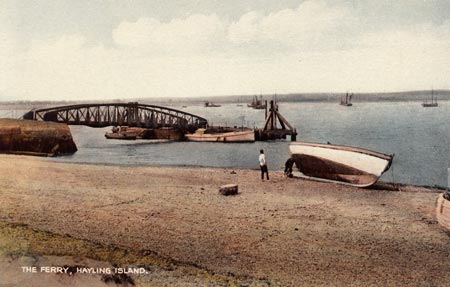
Valentine
postcard of the Hayling ferry
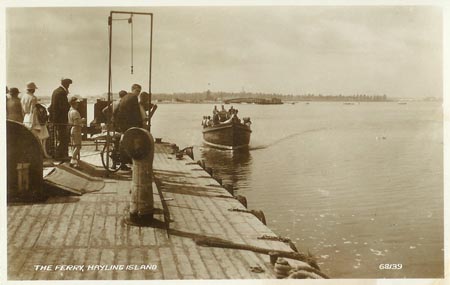
Postcard
of the Hayling ferry Sinah
Michael Sutcliffe
writes:- I lived in Hayling Island in the late 1940's and early
50's and travelled on this ferry, with my bicycle, many times.
My father was in the Marines at Eastney. I think the vessel in
the photo is the 'Sinah', and I well-remember the two stacks
of life belts on the stern. Bicycles, and any other 'cargo' ,
were placed on a raised deck aft of the funnel - where the railing
is in the photograph. Other ferries were brought into service
on bank holidays etc. and when 'Sinah' was being serviced. The
name Spraggs rings a bell - their vessels had grey hulls and
red boot-topping.
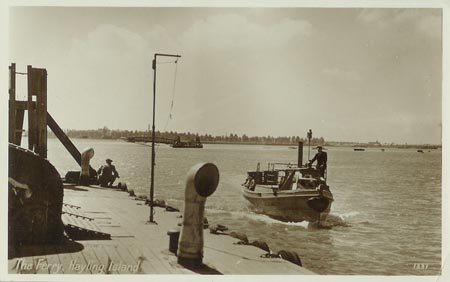
Salmon
postcard of the Hayling ferry, Sinah on the inside berth.
The
ferry leaving appears to be the Iris of 1968 or Irene of 1976,
the last ferries used by Portsmouth City Council
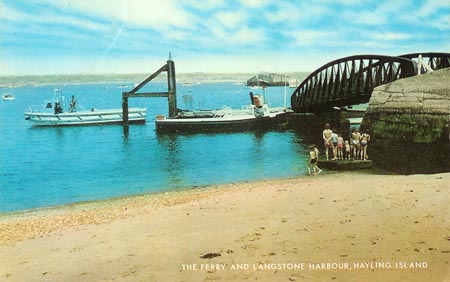
Ferry
pontoon at Hayling Island
Photo:
© Ian Boyle, 17th July 2006
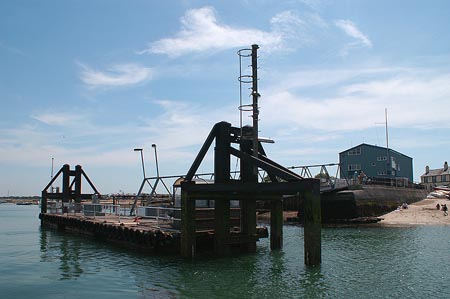
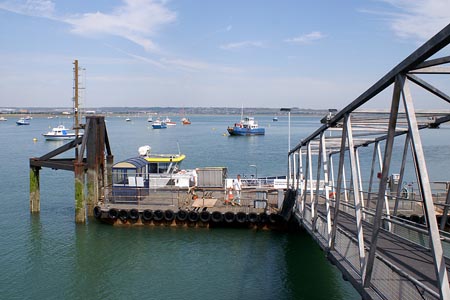
Eastney Ferry Pontoon
(Portsmouth)
For
details see under Hayling Isle Ferry Pontoon
More
images of the Hayling Isle Ferry
Pride
of Hayling
at Eastney
Photo:
© Ian Boyle, 17th July 2006
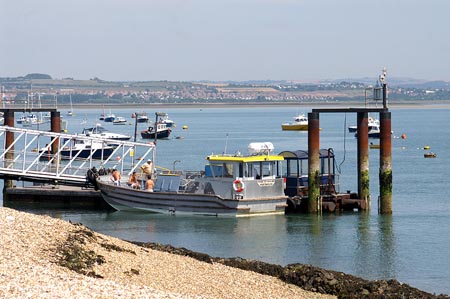
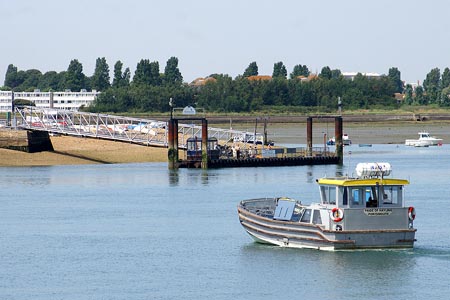
Southsea South Parade
Pier
Postcards
of South Parade Pier






Postcard
of South Parade Pier



Southsea Clarence Pier
Postcard
of Clarence Pier
 Postcard
of Clarence Pier
Postcard
of Clarence Pier
 Postcard
of Clarence Pier
Postcard
of Clarence Pier
 Postcard
of Clarence Pier
Postcard
of Clarence Pier
 Postcard
of Clarence Pier
Postcard
of Clarence Pier

 Postcard
of Clarence Pier
Postcard
of Clarence Pier
 Postcard
of Clarence Pier
Postcard
of Clarence Pier
 Portsmouth Harbour Station
Pier
Kingsway
(WH Smith) postcard of Portsmouth Harbour Station Pier
Portsmouth Harbour Station
Pier
Kingsway
(WH Smith) postcard of Portsmouth Harbour Station Pier

 Gosport Pier
To be
added
Stokes Bay Pier
To be
added
Lee-on-Solent Pier
The resort of
Lee-on-the-Solent was largely the vision of one man, Charles
Edmund Newton Robinson, who persuaded his father (Sir John Charles
Robinson, director of the Victoria & Albert Museum) to buy
up largely unused land for development. The Marine Parade was
constructed first in 1884, followed by the construction (1885-1888)
of a 750ft long pier, with regular steamer service to Southsea.
The (still standing) terrace of shops and balconied apartments
on the east side of Pier Street was part of that development.
The railway
arrived n 1894, and the station building survives, now used as
an amusement arcade. Rail service was discontinued in the 1930.
1935 saw the construction of the Lee Tower complex, a local and
regional landmark with a cinema, ballroom, restaurant, lounge,
and saloon bar - all topped by a striking white tower and clock,
with a 120 ft high observation deck. Nikolas Pevsner described
this as 'a good piece of second-rate inter-war modernism of
the slightly jazzy sort, constructed of concrete when concrete
seemed very up-to-date'. The tower complex was comandeered
by the military during WW2. An attempt to revive its sagging
fortunes was made in 1964, when the interior was reconfigured.
In 1971, the decision was made to demolish the complex. The pier,
too, had a long period of decline. In 1932 a fire destroyed the
popular pavilion at the far end of the pier, which was never
rebuilt. In 1939 it was breached by the military, as were most
southern piers. The damage was never repaired and the remaining
pier structure was demolished in 1958.
Gosport Pier
To be
added
Stokes Bay Pier
To be
added
Lee-on-Solent Pier
The resort of
Lee-on-the-Solent was largely the vision of one man, Charles
Edmund Newton Robinson, who persuaded his father (Sir John Charles
Robinson, director of the Victoria & Albert Museum) to buy
up largely unused land for development. The Marine Parade was
constructed first in 1884, followed by the construction (1885-1888)
of a 750ft long pier, with regular steamer service to Southsea.
The (still standing) terrace of shops and balconied apartments
on the east side of Pier Street was part of that development.
The railway
arrived n 1894, and the station building survives, now used as
an amusement arcade. Rail service was discontinued in the 1930.
1935 saw the construction of the Lee Tower complex, a local and
regional landmark with a cinema, ballroom, restaurant, lounge,
and saloon bar - all topped by a striking white tower and clock,
with a 120 ft high observation deck. Nikolas Pevsner described
this as 'a good piece of second-rate inter-war modernism of
the slightly jazzy sort, constructed of concrete when concrete
seemed very up-to-date'. The tower complex was comandeered
by the military during WW2. An attempt to revive its sagging
fortunes was made in 1964, when the interior was reconfigured.
In 1971, the decision was made to demolish the complex. The pier,
too, had a long period of decline. In 1932 a fire destroyed the
popular pavilion at the far end of the pier, which was never
rebuilt. In 1939 it was breached by the military, as were most
southern piers. The damage was never repaired and the remaining
pier structure was demolished in 1958.
Lee-on-Solent
Pier
 Lee-on-Solent
Pier
Alternative
copy of the card above
Lee-on-Solent
Pier
Alternative
copy of the card above
 Lee-on-Solent
Pier
Variation
on cards above
Lee-on-Solent
Pier
Variation
on cards above

 Lee-on-Solent
Pier
Lee-on-Solent
Pier
 Lee-on-Solent
Pier
Lee-on-Solent
Pier
 Lee-on-Solent
Pier
Lee-on-Solent
Pier
 Lee-on-Solent
Pier
Lee-on-Solent
Pier
 Lee-on-Solent
Pier
Lee-on-Solent
Pier
 Lee-on-Solent
Pier
Lee-on-Solent
Pier
 Warsash Jetty
To be
added
Netley Royal Victoria
Hospital Pier
Netley Pier
was originally built in 1856. It was rebuilt in 1865 for patients
travelling to the huge military hospital opened that year and
had a length of 570 feet. A railway spur served the hospital
from 1901, reducing the use of the pier. However, it was used
for patients to convalecse on until it became unsafe. It was
demolished in 1955.
The hospital
was built after the Crimean War showed the necessity for having
a large military hospital, and it opened in 1863. It was 435
metres long and had around 1000 beds. It was Britain's largest
military hospital, and received extensive use during the Boer
War and the two World Wars. the main building was closed in 1958,
and demolished in 1966 after a major fire in 1963. Only the chapel
still remains. A smaller block behind remained in use until 1978.
the site is now a park.
More images of Southampton Piers, Docks & Ferries
Netley
Pier & Hospital -
Photo copyright (c) T H Wilcox in 1919
Click to open larger image in new window
Warsash Jetty
To be
added
Netley Royal Victoria
Hospital Pier
Netley Pier
was originally built in 1856. It was rebuilt in 1865 for patients
travelling to the huge military hospital opened that year and
had a length of 570 feet. A railway spur served the hospital
from 1901, reducing the use of the pier. However, it was used
for patients to convalecse on until it became unsafe. It was
demolished in 1955.
The hospital
was built after the Crimean War showed the necessity for having
a large military hospital, and it opened in 1863. It was 435
metres long and had around 1000 beds. It was Britain's largest
military hospital, and received extensive use during the Boer
War and the two World Wars. the main building was closed in 1958,
and demolished in 1966 after a major fire in 1963. Only the chapel
still remains. A smaller block behind remained in use until 1978.
the site is now a park.
More images of Southampton Piers, Docks & Ferries
Netley
Pier & Hospital -
Photo copyright (c) T H Wilcox in 1919
Click to open larger image in new window
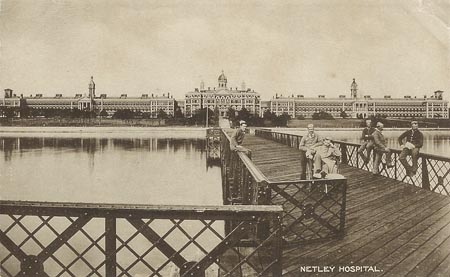 Netley
Pier
Netley
Pier
 Netley
Pier
Netley
Pier
 Netley
Pier
Netley
Pier
 Southampton Royal Pier
The Royal Pier
was opened in 1833 (the first jetty or pier in Southampton).
It was used by steamers to the Channel Islands, Le Havre and
the Isle of Wight. The continental steamers moved to the Outer
Dock once the railway arrived. The London & South Western
Railway arrived in 1840, linking London to Southampton Terminus
Station (although not officially named as such until 1923), less
than a mile from the Royal Pier. A wagon tramway was opened to
the Pier in 1847, initially horse-drawn. The tramway connected
to the the railway via a wagon-turntable, so passenger carriages
could not access it. This was changed from 1871, when a new direct
connection was laid. Carriages were still pulled by horse until
1876, when increasing traffic required their replacement by small
steam locomotives. A small station with single platform was built
at the pier head for passenger trains. Between 5 and seven trains
a day linked the Terminus with the Royal Pier.
In 1864 a pontoon
was added, and the pier head was enlarged in 1871. Major reconstruction
of the pier was carried out in 1892, including a second station
platform and shelters. A pavilion was added soon afterwards.
A new
pier entrance,
with ornate dome, was built in 1930. The tracks were damaged
in the First War, and passenger services did not resume after
the war. Vehicles were side-loaded onto ferries until 1950, when
a ramp for the converted landing craft Norris
Castle (2)
was opened. The pavilion was extended in 1963. However, in 1979
the pier was becoming unsafe and was not economic to maintain
- it was closed in 1982. The Victorian entrance was restored,
and re-opened as a pub/restaurant in 1986. Part of the closed
pier was severely damaged by fire in 1987. In 2006, the pier
entrance
is still in good order, but no longer in use.
More images of Southampton Piers, Docks & Ferries
F.G.O.Stuart
postcard of the Royal Pier.
Note
the railway line and station, plus various early Southampton
Company
paddle steamers
Southampton Royal Pier
The Royal Pier
was opened in 1833 (the first jetty or pier in Southampton).
It was used by steamers to the Channel Islands, Le Havre and
the Isle of Wight. The continental steamers moved to the Outer
Dock once the railway arrived. The London & South Western
Railway arrived in 1840, linking London to Southampton Terminus
Station (although not officially named as such until 1923), less
than a mile from the Royal Pier. A wagon tramway was opened to
the Pier in 1847, initially horse-drawn. The tramway connected
to the the railway via a wagon-turntable, so passenger carriages
could not access it. This was changed from 1871, when a new direct
connection was laid. Carriages were still pulled by horse until
1876, when increasing traffic required their replacement by small
steam locomotives. A small station with single platform was built
at the pier head for passenger trains. Between 5 and seven trains
a day linked the Terminus with the Royal Pier.
In 1864 a pontoon
was added, and the pier head was enlarged in 1871. Major reconstruction
of the pier was carried out in 1892, including a second station
platform and shelters. A pavilion was added soon afterwards.
A new
pier entrance,
with ornate dome, was built in 1930. The tracks were damaged
in the First War, and passenger services did not resume after
the war. Vehicles were side-loaded onto ferries until 1950, when
a ramp for the converted landing craft Norris
Castle (2)
was opened. The pavilion was extended in 1963. However, in 1979
the pier was becoming unsafe and was not economic to maintain
- it was closed in 1982. The Victorian entrance was restored,
and re-opened as a pub/restaurant in 1986. Part of the closed
pier was severely damaged by fire in 1987. In 2006, the pier
entrance
is still in good order, but no longer in use.
More images of Southampton Piers, Docks & Ferries
F.G.O.Stuart
postcard of the Royal Pier.
Note
the railway line and station, plus various early Southampton
Company
paddle steamers
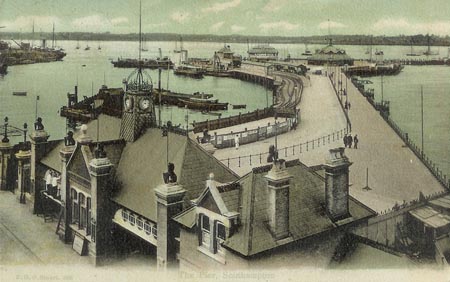 Postcard
of the Royal Pier.
Postcard
of the Royal Pier.
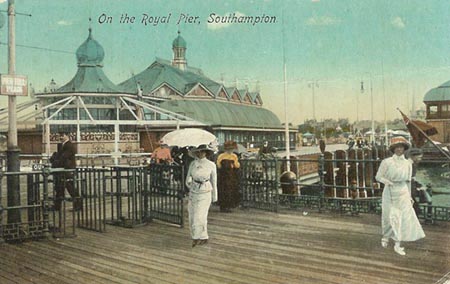 A well-known
photograph of the Southampton at the Royal Pier, Southampton.
Issued
here as a Pamlin Prints postcard.
A well-known
photograph of the Southampton at the Royal Pier, Southampton.
Issued
here as a Pamlin Prints postcard.
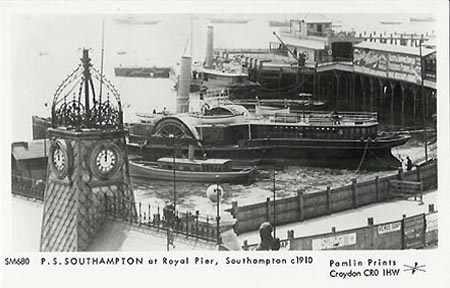 A variation
on the photograph above of the Royal Pier, clearly showing the
station.
A variation
on the photograph above of the Royal Pier, clearly showing the
station.
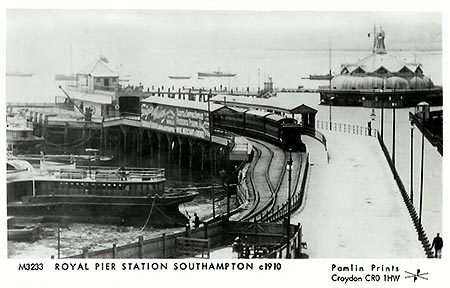 Postcard
of the Royal Pier.
Note
additional pier buildings compared to the photo above.
Postcard
of the Royal Pier.
Note
additional pier buildings compared to the photo above.
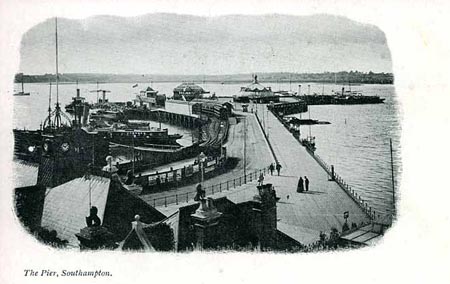 Postcard
of Balmoral
(1)
at the Royal Pier.
Postcard
of Balmoral
(1)
at the Royal Pier.
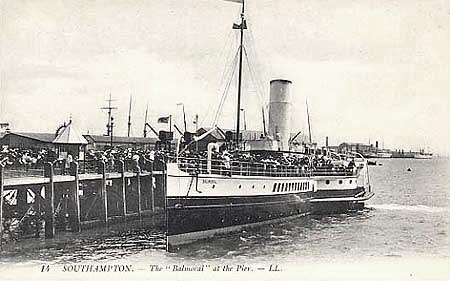 Postcard
CM.5007 of the Royal Pier.
Queen
Elizabeth
proceeding to New Docks, Vecta at royal Pier
Postcard
CM.5007 of the Royal Pier.
Queen
Elizabeth
proceeding to New Docks, Vecta at royal Pier
 Kingsway postcard S19627 of the 1930
Royal Pier entrance.
Railway
line and station removed, plus various Southampton
Company
with black-topped funnels
Kingsway postcard S19627 of the 1930
Royal Pier entrance.
Railway
line and station removed, plus various Southampton
Company
with black-topped funnels
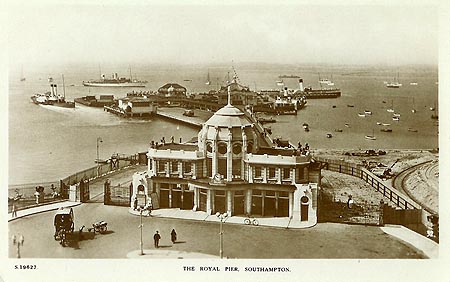 Excel
postcard of the later Royal Pier entrance.
Excel
postcard of the later Royal Pier entrance.
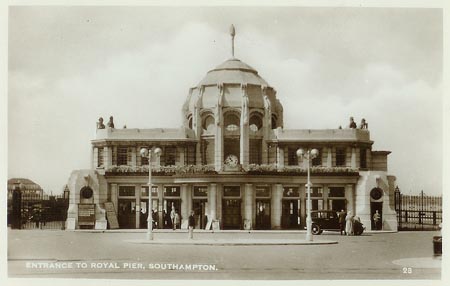 Salmon
postcard of the Royal Pier entrance in the 1960s.
Salmon
postcard of the Royal Pier entrance in the 1960s.
 The Royal Pier entrance in 2006.
The
building remains in good order, but is not obviously in use
Photo:
© Ian Boyle, Southampton, 23rd April 2006
The Royal Pier entrance in 2006.
The
building remains in good order, but is not obviously in use
Photo:
© Ian Boyle, Southampton, 23rd April 2006
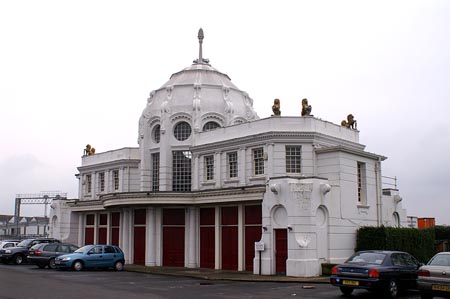 Southampton
Royal Pier
Photo:
© Ian Boyle, 4th August 2006
Southampton
Royal Pier
Photo:
© Ian Boyle, 4th August 2006